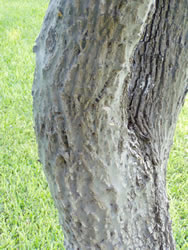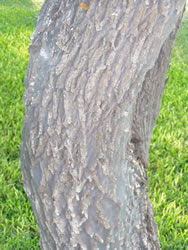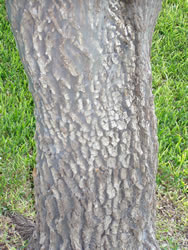Search
For The Answer
Click here to access our database of
Plant Answers
Search
For The Picture
Click here to access the Google database of plants
and insects
Information
Index
Alphabetical Listing of Topics, Recommendations
and Plants
Milberger's Nursery and Landscaping
3920 North Loop 1604 E.
San Antonio, TX 78247
210.497.3760
nursery@milbergersa.com
Open 9 to 6 Mon. through Sat.
and 10 to 5 on Sun.

Three exits east of 281, inside of 1604
Next to the Diamond Shamrock station
Please click map for more detailed map and driving directions.
Question: Something is making webs all over the trunk of my tree. Is this doing damage? Should I try to kill the spiders or whatever is doing this? Answer: These webs are harmless and are being caused by barklice rather than spiders. Barklice occur on the trunks of a number of trees where they feed on lichens, molds and fungi growing on the bark. Therefore, they may actually be considered to be beneficial insects since they perform the service of cleaning the trunks of trees. Species belonging to two families of barklice are commonly encountered in Texas: Psocidae ant Pseudocaecilliidae. Psocidae are about 1/4 of an inch long and are black in color. They live in clusters on the bark made up of many individuals in similar stages of development. Consequently, tight clusters of wingless immatures and clusters of winged adults located on the trunks of trees such as Arizona ash are encountered at about eye level. From a distance these clusters often look like knotholes. The aggregated clusters of barklice move like herds of cattle on the bark. The Pseudocaeciliitae are much smaller in size, duller in color and adults bear wings. The species most noticeable, Archkipsocus nomas Gurney, makes unsightly silken webs on tree trunks and branches These webs can completely wrap a tree's trunk to the tips of each branch. Underneath this protective webbing, the barklice feed on lichens and fungi. Host trees commonly include oaks and pecans, although any tree with lichen and fungal growth on the bark can support a barklouse population. Silk-wrapped trees harboring this barklouse appear to occur at specific periods of the summer (July and August) when conditions are favorable for their development. The appearance of webbing often causes concern to homeowners and landscape maintenance personnel that are not familiar with this insect. Pseudocaeciliid barklice are harmless to
trees and no insecticides are recommended for their control. Once
silken webbing appears, it will not be removed by chemical treatments.
If removal of the silk is desired, it may be |
||||||







